(Daniel Chapter 2) What Does the Metallic Image Represent?
Posted Jun 30, 2021 by Kevin J. Mullins in Questions Concerning Bible Prophecy
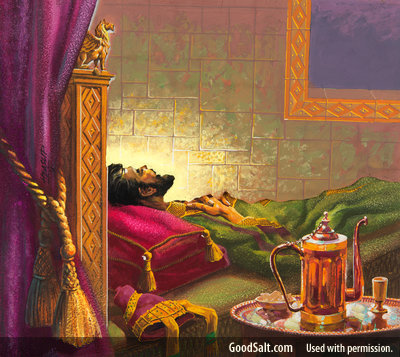 In Daniel Chapter 2 we read of the king of Babylon whose name was Nebuchadnezzar. In the story King Nebuchadnezzar has a dream one night, but when he awakes, he cannot remember all the details about it. The dream must have had a big impact on him for he sought earnestly to recall it and understand its meaning. His first step of action was to call on all the wise men of Babylon known as “the magicians, and the astrologers, and the sorcerers, and the Chaldeans” (Daniel 2:2) to, not only interpret his dream, but to tell him what he dreamt! He told the wise men, “tell me the dream, and I shall know that ye can show me the interpretation thereof” (verse 9). If these so-called “wise men” could read his mind and tell him what he dreamt he would know for sure that the interpretation was true.
In Daniel Chapter 2 we read of the king of Babylon whose name was Nebuchadnezzar. In the story King Nebuchadnezzar has a dream one night, but when he awakes, he cannot remember all the details about it. The dream must have had a big impact on him for he sought earnestly to recall it and understand its meaning. His first step of action was to call on all the wise men of Babylon known as “the magicians, and the astrologers, and the sorcerers, and the Chaldeans” (Daniel 2:2) to, not only interpret his dream, but to tell him what he dreamt! He told the wise men, “tell me the dream, and I shall know that ye can show me the interpretation thereof” (verse 9). If these so-called “wise men” could read his mind and tell him what he dreamt he would know for sure that the interpretation was true.
After hearing the king’s demands the Chaldeans spoke up and said, “There is not a man upon the earth that can show the king's matter … there is none other that can show it before the king, except the gods, whose dwelling is not with flesh” (Daniel 2:10,11). Here we see the Babylonian idea of the worship of many “gods”; and not just many gods, but the belief that the gods’ “dwelling is not with flesh” and have no real personal interests in humans besides handing out punishments. However, in the first chapter of the book of John we read:
“In the beginning was the Word, and the Word was with God, and the Word was God. The same was in the beginning with God. All things were made by Him; and without Him was not any thing made that was made. In Him was life; and the life was the light of men … And the Word was made flesh, and dwelt among us, (and we beheld His glory, the glory as of the only begotten of the Father,) full of grace and truth.” (John 1:1-4, 14)
Scripture confirms that this "Word" which "was made flesh, and dwelt among us" is Jesus, the only begotten Son of God (Revelation 19:13). Jesus is the thoughts of the Father made audible and visible. Out of His deep interest and unselfish love for His creation, God sent His Son to this world (John 3:16). In Jesus we behold the glory (the true character) of the Father, which draws us unto Him in repentance (Romans 2:4).
In one of John’s other letters, he wrote that it is antichrist to believe Jesus did not overcome sin while in human flesh:
“For many deceivers are entered into the world, who confess not that Jesus Christ is come in the flesh. This is a deceiver and an antichrist.” (2 John 1:7)
In Matthew 1:23 we read:
“Behold, a virgin shall be with child, and shall bring forth a Son, and they shall call His name Emmanuel, which being interpreted is, God with us.” (Matthew 1:23)
Jesus is God by nature because He came forth from God (John 8:42) "in the days of eternity" (Micah 5:2), and when He was here physically 2,000 years ago, or when His Spirit lives in our hearts, God is truly with us. Not only is the Son of God with us when He is in our hearts, but His Father is also with us in Christ, for “God was in Christ, reconciling the world unto Himself” (2 Corinthians 5:19). As the "express image" of the Father's person (Hebrews 1:3), Jesus is the only way to have "God with us"; thus if we have the Son of God in our hearts we cannot help but have “God with us.”
"... I (Jesus) am the Way, the Truth, and the Life: no man cometh unto the Father, but by Me ... he that hath seen Me hath seen the Father ... Believest thou not that I am in the Father, and the Father in Me? the words that I speak unto you I speak not of Myself: but the Father that dwelleth in Me, He doeth the works. Believe Me that I am in the Father, and the Father in Me ... If a man love Me, he will keep My words: and My Father will love him, and WE will come unto him, and make OUR abode with him.” (John 14:6, 9, 10, 11, 23)
Paul wrote to Timothy saying:
"And without controversy great is the mystery of godliness: God was manifest in the flesh, justified in the Spirit, seen of angels, preached unto the Gentiles, believed on in the world, received up into glory." (1 Timothy 3:16)
God dwelt and was "manifest (revealed) in the flesh" through His Son Jesus and will dwell and be manifest (revealed) in the flesh through us who possess the Spirit of Christ. What God did in and through Jesus, He promises to do in and through us:
“For what the Law could not do in that it was weak through the flesh [the Law cannot save us from sinning], God did by sending His own Son in the likeness of sinful flesh, on account of sin: He condemned sin in the flesh: That the righteousness of the Law might be fulfilled in us, who walk not after the flesh, but after the Spirit.” (Romans 8:3, 4)
This is not accomplished by our own works, but by the Spirit of Christ working in and through us. By grace through faith we will become “partakers of the divine nature" as it works through our flesh in order to escape "the corruption that is in the world through lust" (2 Peter 1:4); for those who "walk in the Spirit ... shall not fulfil the lust of the flesh" (Galatians 5:16; We'll discuss more of this as we continue this series).
After the Chaldeans denied his request, the king demanded that all the wise men of Babylon be put to death. Daniel, who was recently captured from the land of Jerusalem and held special recognition by the king, and considered to be one of the wise men, immediately wanted to see the king. When Daniel was with the king, he asked the king if he would grant him some time to call on the one true God to reveal the dream to him. Nebuchadnezzar accepted Daniel’s request and Daniel went home safely. “Then was the secret revealed unto Daniel in a night vision. Then Daniel blessed the God of heaven.” (Daniel 2:19).
That night Daniel had the same dream as king Nebuchadnezzar. Daniel sought for the king and made it known that he could tell the dream and its interpretation. On his arrival Daniel proclaimed:
“… The secret which the king hath demanded cannot the wise men, the astrologers, the magicians, the soothsayers, show unto the king; But there is a God in heaven that revealeth secrets, and maketh known to the king Nebuchadnezzar what shall be in the latter days …” (Daniel 2:27, 28)
By giving the king this dream, God was desiring to make Himself known to the king. He wanted the king to know that there truly is “one God, the Father, of whom are all things, and we in Him; and one Lord Jesus Christ, by whom are all things, and we by Him” (1 Corinthians 8:6).
Daniel said the God of heaven “revealeth secrets.” Through His affectionate unselfish love, God, through His prophets such as Daniel, will never hold anything good from His people—“Surely the Lord GOD will do nothing, but He revealeth His secret unto His servants the prophets” (Amos 3:7).
After Daniel accurately told the king what he had dreamt and gave its interpretation the king boldly said, “Of a truth it is, that your God is a God of gods, and a Lord of kings, and a revealer of secrets, seeing thou couldest reveal this secret” (Verse 47). By giving this dream and telling its interpretation, God, through the prophet Daniel, led this pagan king to reverence the name of the living God. So, what did the king dream?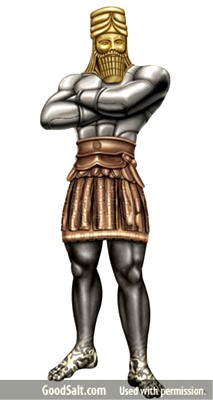


“Thou, O king, sawest, and behold a great image. This great image, whose brightness was excellent, stood before thee; and the form thereof was terrible. This image's head was of fine gold, his breast and his arms of silver, his belly and his thighs of brass, His legs of iron, his feet part of iron and part of clay. Thou sawest till that a stone was cut out without hands, which smote the image upon his feet that were of iron and clay, and brake them to pieces. Then was the iron, the clay, the brass, the silver, and the gold, broken to pieces together, and became like the chaff of the summer threshingfloors; and the wind carried them away, that no place was found for them: and the stone that smote the image became a great mountain, and filled the whole earth.” (Daniel 2:31-35)
King Nebuchadnezzar’s dream was of a great image whose head was made of gold, his chest and arms made of silver, his belly and thighs made of brass (or, bronze), his legs made of iron, and his feet made of iron and clay. Then a stone fell and caused the whole image to crumble. Now let’s listen as Daniel and his companions begins to interpret the dream:
The Head of Gold
“This is the dream; and we will tell the interpretation thereof before the king. Thou, O king, [Nebuchadnezzar] art a king of kings: for the God of heaven hath given thee a kingdom, power, and strength, and glory. And wheresoever the children of men dwell, the beasts of the field and the fowls of the heaven hath he given into thine hand, and hath made thee ruler over them all. Thou art this head of gold.” (Daniel 2:36-38)
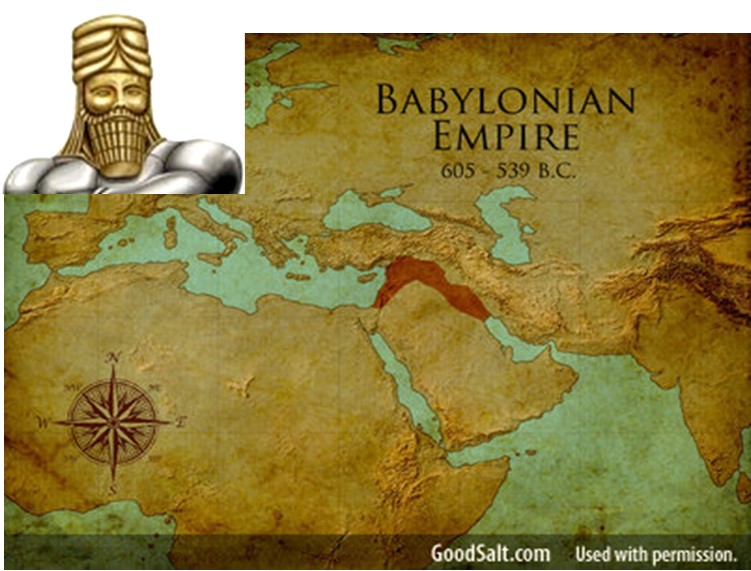 Daniel says that the image’s golden head represents king Nebuchadnezzar. Not only does the golden head represent Nebuchadnezzar, but Scripture makes it clear that it is primarily his kingdom. Notice what Daniel and his companions say regarding the image’s chest and arms of silver and the belly and thighs of brass:
Daniel says that the image’s golden head represents king Nebuchadnezzar. Not only does the golden head represent Nebuchadnezzar, but Scripture makes it clear that it is primarily his kingdom. Notice what Daniel and his companions say regarding the image’s chest and arms of silver and the belly and thighs of brass:
“And after thee [king] shall arise another kingdom inferior to thee, and another third kingdom of brass, which shall bear rule over all the earth” (Verse 39)
A good rule of thumb to remember is whenever the prophets of God tell us about various kingdoms or empires, they always begin with the kingdom that is ruling at that time. When Daniel and his companions were giving the interpretation of this dream, they were captives in the kingdom of Babylon. It was king Nebuchadnezzar who sent his Babylonian armies to Jerusalem and besieged it (see Daniel 1:1). When Daniel says these various metals represent various kingdoms and points out that the head of gold represents king Nebuchadnezzar, he is saying that the head of gold represents the kingdom of Babylon. We also read in the book of Isaiah that God called the kingdom of Babylon, “the golden city” (Isaiah 14:4).
By knowing that these four metals represent four world kingdoms, and that the first kingdom is Babylon, we can turn to the history books, as well as the Scriptures, to find out the last remaining three kingdoms.
The Silver Chest and Arms
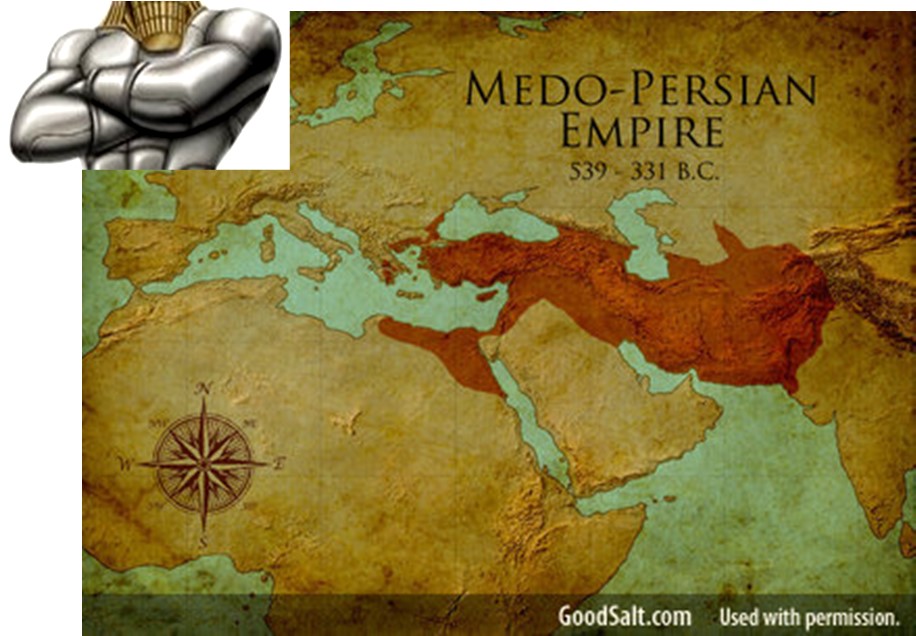 Daniel and his companions go on to say that the silver chest and arms represent a kingdom that would follow Babylon. History tells us that was the kingdom of Medo-Persia. Scripture also shows this in the 5th chapter of the book of Daniel when Daniel says to Belshazzar (Babylon’s last king) that “God hath numbered thy kingdom, and finished it … Thy kingdom is divided, and given to the Medes and Persians” (Daniel 5:26, 28). Thus, one of the image’s arms represents the Medes while the other represents the Persians. Most artists depict this image as standing with its arms crossed showing the alliance between them.
Daniel and his companions go on to say that the silver chest and arms represent a kingdom that would follow Babylon. History tells us that was the kingdom of Medo-Persia. Scripture also shows this in the 5th chapter of the book of Daniel when Daniel says to Belshazzar (Babylon’s last king) that “God hath numbered thy kingdom, and finished it … Thy kingdom is divided, and given to the Medes and Persians” (Daniel 5:26, 28). Thus, one of the image’s arms represents the Medes while the other represents the Persians. Most artists depict this image as standing with its arms crossed showing the alliance between them.
The Belly and Thighs of Brass/Bronze
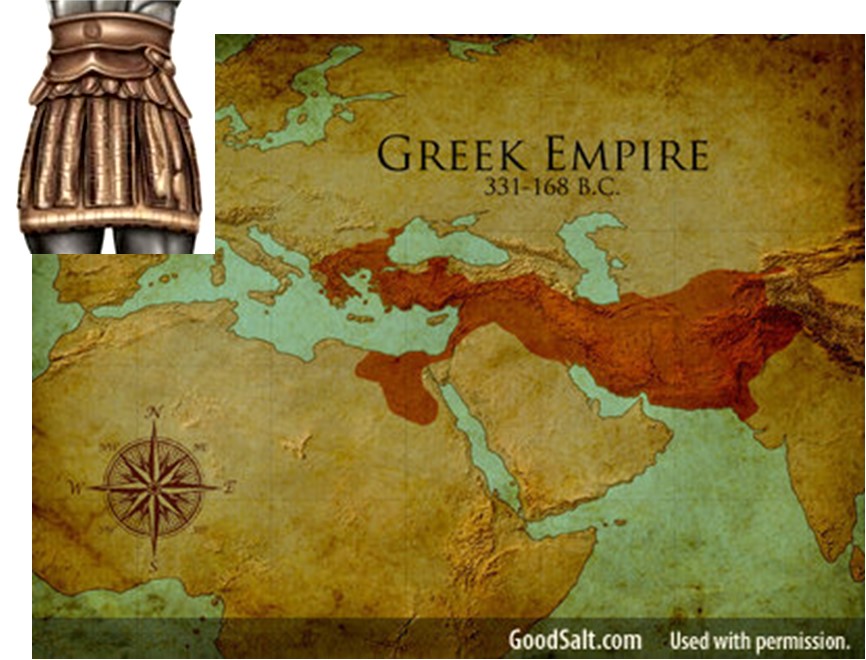 Daniel says the belly and thighs of brass represent the third kingdom. History tells us that it was Greece, led by Alexander the Great, who overran the Medo-Persians in the battle of Arbela in 331 B.C. Scripture also states this in Daniel chapter 8 where Daniel has a vision of a ram with two horns and a goat with one horn. After Daniel sees the goat defeat the ram an angel tells him, “The ram which thou sawest having two horns are the kings of Media and Persia. And the rough goat is the king of Grecia: and the great horn that is between his eyes is the first king (which represents Alexander the Great).” (Daniel 8:20, 21). Greece is also known to have been a major hub of activity during the Bronze Age.
Daniel says the belly and thighs of brass represent the third kingdom. History tells us that it was Greece, led by Alexander the Great, who overran the Medo-Persians in the battle of Arbela in 331 B.C. Scripture also states this in Daniel chapter 8 where Daniel has a vision of a ram with two horns and a goat with one horn. After Daniel sees the goat defeat the ram an angel tells him, “The ram which thou sawest having two horns are the kings of Media and Persia. And the rough goat is the king of Grecia: and the great horn that is between his eyes is the first king (which represents Alexander the Great).” (Daniel 8:20, 21). Greece is also known to have been a major hub of activity during the Bronze Age.
The Legs of Iron
Daniel and his companions say the legs of iron represent the fourth kingdom. History tells us that it was Rome who conquered Greece at the battle of Pydna in 168 B.C. Also notice that Rome is represented by iron. The Roman Empire is often referred to as “The Iron Monarchy.” And when the empire was at its strongest it is referred to as “The Iron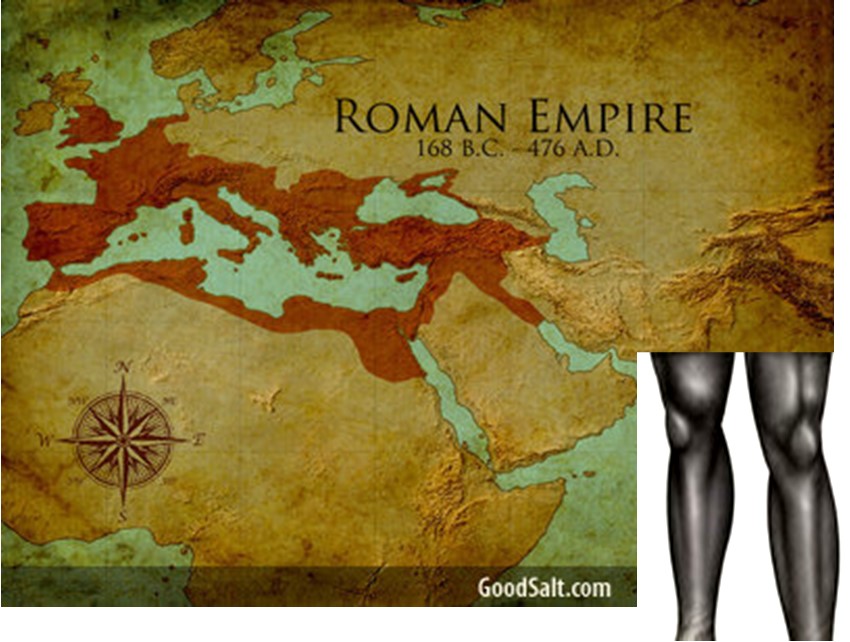 Age” because they were known for their iron weapons. Non-Christian historian Edward Gibbon wrote, “The images of gold, or silver, or brass, that might serve to represent the nations and their kings, were successively broken by the iron monarchy of Rome.” (The History of the Decline and Fall of the Roman Empire, Ch. 38, p. 161).
Age” because they were known for their iron weapons. Non-Christian historian Edward Gibbon wrote, “The images of gold, or silver, or brass, that might serve to represent the nations and their kings, were successively broken by the iron monarchy of Rome.” (The History of the Decline and Fall of the Roman Empire, Ch. 38, p. 161).
Just as legs are the longest part of the body Rome reigned the longest than the three previous world empires. However, Daniel goes on to say that the kingdom of Rome would be divided:
The Feet of Iron and Clay
“And whereas thou sawest the feet and toes, part of potters' clay, and part of iron, the kingdom shall be divided; but there shall be in it of the strength of the iron, forasmuch as thou sawest the iron mixed with miry clay. And as the toes of the feet were part of iron, and part of clay, so the kingdom shall be partly strong, and partly broken.” (Daniel 2:41, 42)
Just as there is a total of ten toes on two feet, Rome was divided into ten nations in the year 476 A.D. when the Barbaric tribes from north of Europe and Asia overran the Roman empire dividing it into exactly ten parts which later became the nations of modern Europe. They were:

.jpg)


There is a reason why the last three are extinct today. Bible prophecy actually foretold it! We will discuss this in another study.
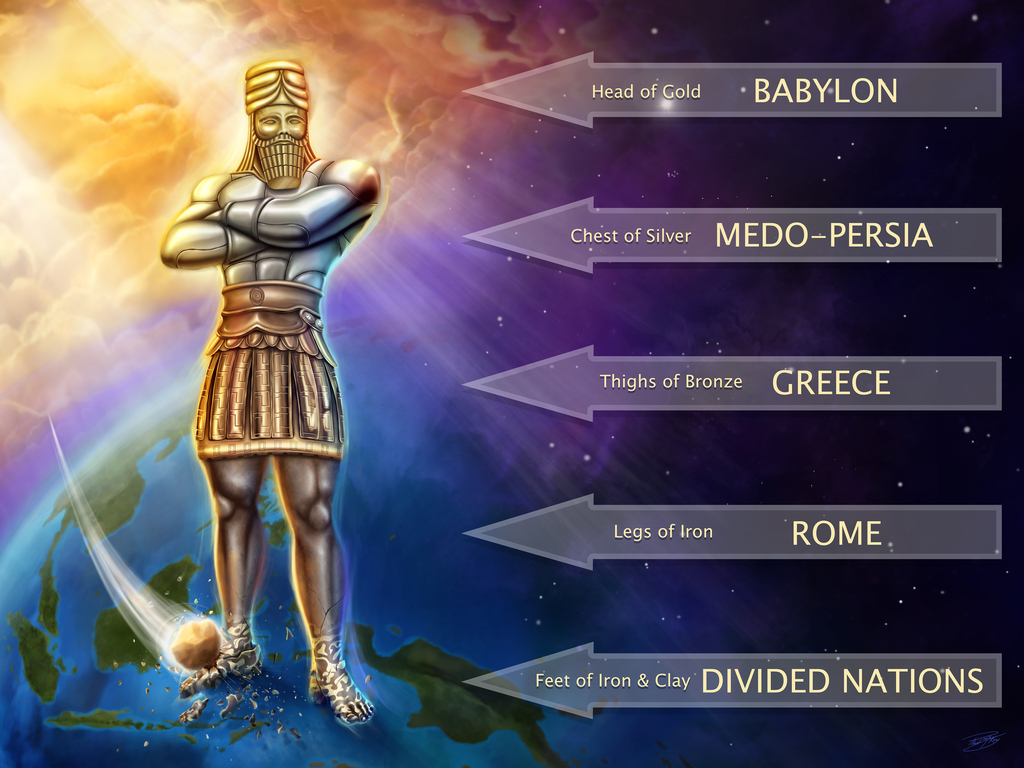
After Daniel says, “the kingdom shall be partly strong, and partly broken” (Daniel 2:42), he says, “And whereas thou sawest iron mixed with miry clay, they shall mingle themselves with the seed of men: but they shall not cleave one to another, even as iron is not mixed with clay” (Verse 43).
This has been accurately fulfilled, as down through the history of Europe there have always been some nations strong, while others have been weak. Repeated failed efforts have also been made to weld the fragments of Europe by intermarriage between ruling families, especially in the period between 1850 and 1914. Men such as Charlemagne, Charles V, Louis XIV, Napoleon, Kaiser Wilhelm and Adolf Hitler have all tried in vain to unite Europe.
The Crushing Stone
We now know that the head of gold represents the kingdom of Babylon. The chest and arms of silver represent the kingdom of Medo-Persia. The belly and thighs of brass represent the kingdom of Greece. The legs of iron represent the kingdom of Rome. And the feet and toes of part iron and clay represent the divided nations of the Roman kingdom. We must now find out more about that stone that struck the image’s feet causing the whole image to crumble.
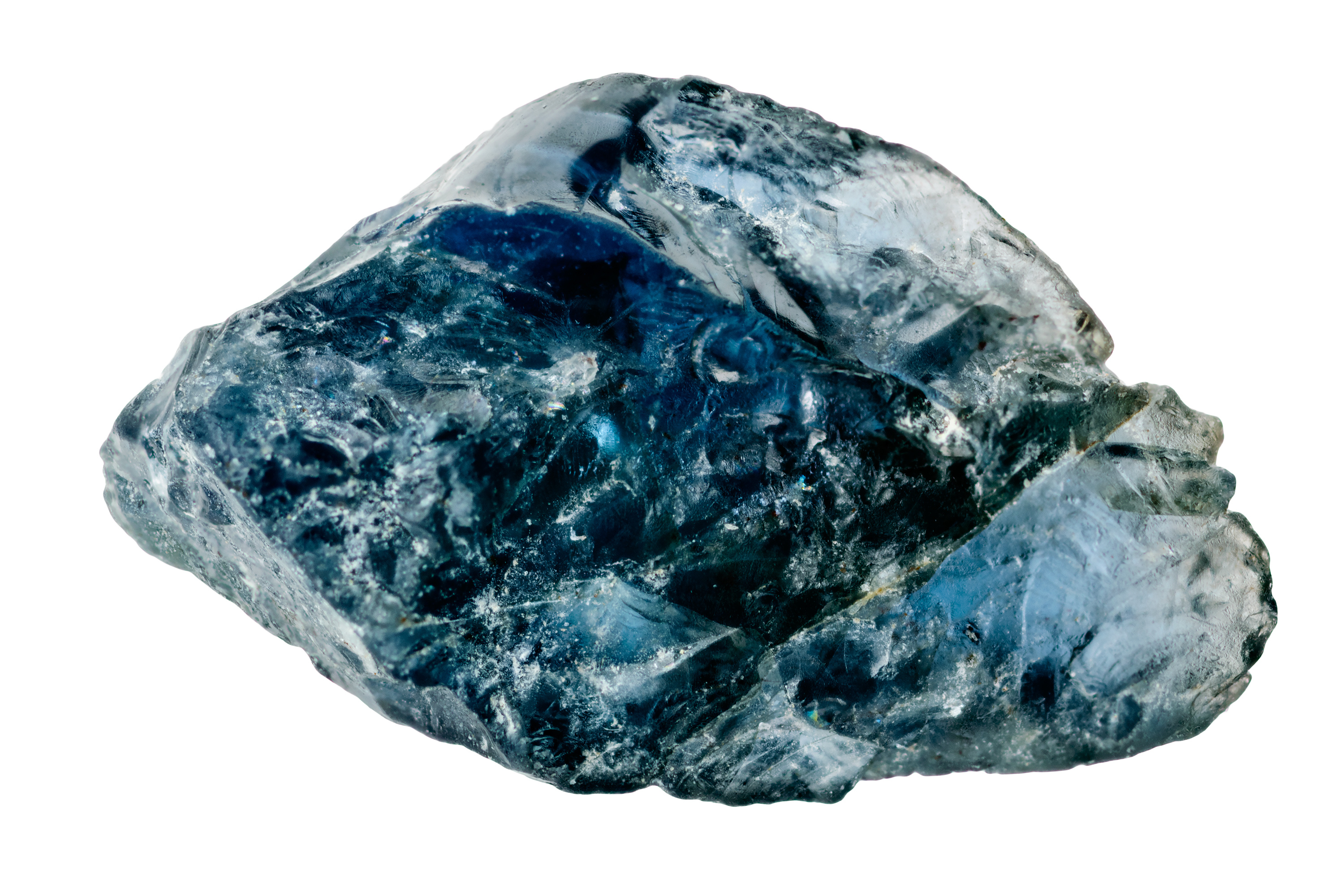 “And in the days of these kings shall the God of heaven set up a kingdom, which shall never be destroyed: and the kingdom shall not be left to other people, but it shall break in pieces and consume all these kingdoms, and it shall stand for ever. Forasmuch as thou sawest that the stone was cut out of the mountain without hands, and that it brake in pieces the iron, the brass, the clay, the silver, and the gold; the great God hath made known to the king what shall come to pass hereafter: and the dream is certain, and the interpretation thereof sure.” (Daniel 2:44, 45)
“And in the days of these kings shall the God of heaven set up a kingdom, which shall never be destroyed: and the kingdom shall not be left to other people, but it shall break in pieces and consume all these kingdoms, and it shall stand for ever. Forasmuch as thou sawest that the stone was cut out of the mountain without hands, and that it brake in pieces the iron, the brass, the clay, the silver, and the gold; the great God hath made known to the king what shall come to pass hereafter: and the dream is certain, and the interpretation thereof sure.” (Daniel 2:44, 45)
The stone that crushed the image represents the time when God will “set up a kingdom which shall never be destroyed.” Jesus is often represented in Scripture as being a Stone or “Rock”:
“Now therefore ye are no more strangers and foreigners, but fellowcitizens with the saints, and of the household of God; And are built upon the foundation of the apostles and prophets, Jesus Christ Himself being the chief corner stone; In whom all the building fitly framed together groweth unto an holy temple in the Lord: In whom ye also are builded together for an habitation of God through the Spirit.” (Ephesians 2:19-22)
“Jesus said to them, ‘Have you never read in the Scriptures: The stone the builders rejected has become the cornerstone. This is from the Lord, and it is marvelous in our eyes’? Therefore I tell you that the kingdom of God will be taken away from you and given to a people who will produce its fruit. He who falls on this stone will be broken to pieces, but he on whom it falls will be crushed.” (Matthew 21:42-44, Berean Study Bible)
“Moreover, brethren, I would not that ye should be ignorant, how that all our fathers were under the cloud, and all passed through the sea; And were all baptized unto Moses in the cloud and in the sea; And did all eat the same spiritual meat; And did all drink the same spiritual drink: for they drank of that spiritual Rock that followed them: and that Rock was Christ.” (1 Corinthians 10:1-4)
Thus, a stone crushing all these man-made kingdoms is fitting to represent God’s kingdom of love when “The kingdoms of this world are become the kingdoms of our Lord, and of His Christ; and he shall reign for ever and ever” (Revelation 11:15). In Genesis 10:8-10 we read that it was Nimrod who was the founder of ancient Babylon. Nimrod was worshipped as a god who led the people away from the one true God and into a government of tyranny.
"Now it was Nimrod who excited them to such an affront and contempt of God. He was the grandson of Ham, the son of Noah, a bold man, and of great strength of hand. He persuaded them not to ascribe it [strength/life] to God, as if it were through his means they were happy, but to believe it was their own courage which procured that happiness. He [Nimrod] also gradually changed the government into tyranny, seeing no other way of turning men from the fear of God, but to bring them into a constant dependence on his power ..." (Josephus, Antiquities, Book 1, Chap. 4, Par 2)
Nimrod had enforced a government/citizen relationship, with the government controlling or guiding the citizen by force. God's system of government is based on family relationship, with the parents controlling (lovingly guiding) the children. The curse of Babylon upon Medo-Persia, Greece and Rome is that the seed of broken family relationships can turn into despotic ruling nations.
"With the setting up of Nimrod's kingdom, the entire ancient world entered a new historical phase. The oriental tradition which makes that warrior the first man who wore a kingly crown, points to a fact more significant than the assumption of a new ornament of dress, or even a conquest of a province. His reign introduced to the world a new system of relations between the governor and the governed. The authority of former rulers had rested upon the feeling of kindred, and the ascendancy of the chief was an image of parental control [i.e. guidance]. Nimrod, on the contrary, was a sovereign of territory, and of men just so far as they were its inhabitants, and irrespective of personal ties. Hitherto there had been tribes - enlarged families - Society; now there was a nation, a political community - the State." (A.T. Jones, Empires of the Bible, p. 51)
Notice right off that it's "the warrior" who is made a king to rule over the people, not an endearing father, but a mighty warrior who kills those who oppose him. Christ's everlasting kingdom, however, is the complete opposite as He leads His people back to a loving family relationship (oneness) with our heavenly Father. This everlasting kingdom is also mentioned in Daniel chapter 7:
“I saw in the night visions, and, behold, one like the Son of man (the Messiah/Jesus) came with the clouds of heaven, and came to the Ancient of days (God the Father), and they brought Him (Jesus) near before Him (the Father). And there was given Him (Jesus) dominion, and glory, and a kingdom, that all people, nations, and languages, should serve Him: His dominion is an everlasting dominion, which shall not pass away, and His kingdom that which shall not be destroyed.” (Daniel 7:13, 14)
In an article on characterofgod.org entitled, Law of the Sword, Emmanuel Eshun writes this concerning Christ's everlasting kingdom:
“How come this power of the ‘Son of Man’ would never be destroyed by another power? The traditional interpretation has been that it is because God is omnipotent, therefore when He crushes all the world powers by His limitless compelling power, violence and force, there will be left no one to ever challenge God again. But is this what the principle of the sword teaches us about God’s government? A big no … Why does the kingdom of the ‘Son of Man’ last forever? This is it, it operates on an opposite principle to all the powers that we have seen in history. He never uses the sword, force, nor compelling power [Zechariah 4:6; Matthew 26:51, 52; Luke 22:49-51]. His is the ‘Sword of the Spirit’ – TRUTH, LOVE AND FREEDOM [Ephesians 6:17]. In this kingdom, the King and His ‘servants’ present the truth in love and leave people free to receive or reject it. Instead of force, freedom; instead of killing His opponents, He dies in their place; instead of compelling His subjects to submit, He transforms and melts their hardened hearts by the revelation of His never changing love for them [Jeremiah 31:3]. And for those who will never choose to be conformed to His image, He leaves free to ‘depart from His presence’ and to ‘Cry to the rocks and mountains to hide them’. However, know that to depart from God [the only source of life] means death. ‘…Yes, woe to them when I depart from them!’ (Hosea 9:12).”
We'll speak more of this as we continue in this series, for we know that the spirit of Babylon will seek to control the whole earth:
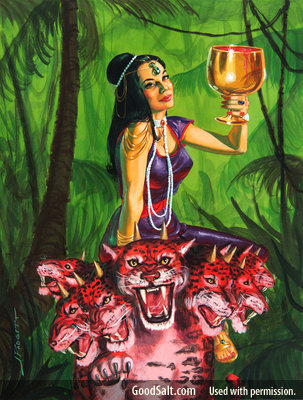 "And there came one of the seven angels which had the seven vials, and talked with me (John), saying unto me, Come hither; I will show unto thee the judgment of the great whore that sitteth upon many waters: With whom the kings of the earth have committed fornication, and the inhabitants of the earth have been made drunk with the wine of her fornication. So he carried me away in the spirit into the wilderness: and I saw a woman sit upon a scarlet coloured beast, full of names of blasphemy, having seven heads and ten horns. And the woman was arrayed in purple and scarlet colour, and decked with gold and precious stones and pearls, having a golden cup in her hand full of abominations and filthiness of her fornication: And upon her forehead was a name written, MYSTERY, BABYLON THE GREAT, THE MOTHER OF HARLOTS AND ABOMINATIONS OF THE EARTH. And I saw the woman drunken with the blood of the saints, and with the blood of the martyrs of Jesus: and when I saw her, I wondered with great admiration." (Revelation 17:1-6)
"And there came one of the seven angels which had the seven vials, and talked with me (John), saying unto me, Come hither; I will show unto thee the judgment of the great whore that sitteth upon many waters: With whom the kings of the earth have committed fornication, and the inhabitants of the earth have been made drunk with the wine of her fornication. So he carried me away in the spirit into the wilderness: and I saw a woman sit upon a scarlet coloured beast, full of names of blasphemy, having seven heads and ten horns. And the woman was arrayed in purple and scarlet colour, and decked with gold and precious stones and pearls, having a golden cup in her hand full of abominations and filthiness of her fornication: And upon her forehead was a name written, MYSTERY, BABYLON THE GREAT, THE MOTHER OF HARLOTS AND ABOMINATIONS OF THE EARTH. And I saw the woman drunken with the blood of the saints, and with the blood of the martyrs of Jesus: and when I saw her, I wondered with great admiration." (Revelation 17:1-6)
Notice Babylon is seated upon "a scarlet coloured beast, full of blasphemy, having seven heads and ten horns." In Daniel chapter 2, Daniel sees his vision of the stone and God’s everlasting kingdom right after he sees the four various metals of the man-like image, with the feet obviously having ten “toes.” In Daniel chapter 7, Daniel again sees this vision of God’s everlasting kingdom right after he had a vision concerning four various beasts, with the fourth beast having “ten horns” (verse 7). Could these four beasts correlate with the four metals and have anything to do with the spirit of Babylon in the last days?
We’ll find out in our next study: Daniel Chapter 7
